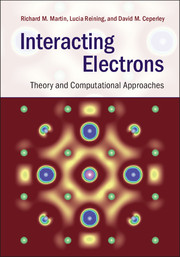Book contents
- Frontmatter
- Dedication
- Contents
- Preface
- Acknowledgments
- Notation
- Part I Interacting electrons: beyond the independent-particle picture
- Part II Foundations of theory for many-body systems
- Part III Many-body Green's function methods
- Part IV Stochastic methods
- Part V Appendices
- Appendix A Second quantization
- Appendix B Pictures
- Appendix C Green's functions: general properties
- Appendix D Matsubara formulation for Green's functions for T ≠ 0
- Appendix E Time ordering, contours, and non-equilibrium
- Appendix F Hedin's equations in a basis
- Appendix G Unique solutions in Green's function theory
- Appendix H Properties of functionals
- Appendix I Auxiliary systems and constrained search
- Appendix J Derivation of the Luttinger theorem
- Appendix K Gutzwiller and Hubbard approaches
- References
- Index
Appendix J - Derivation of the Luttinger theorem
from Part V - Appendices
Published online by Cambridge University Press: 05 June 2016
- Frontmatter
- Dedication
- Contents
- Preface
- Acknowledgments
- Notation
- Part I Interacting electrons: beyond the independent-particle picture
- Part II Foundations of theory for many-body systems
- Part III Many-body Green's function methods
- Part IV Stochastic methods
- Part V Appendices
- Appendix A Second quantization
- Appendix B Pictures
- Appendix C Green's functions: general properties
- Appendix D Matsubara formulation for Green's functions for T ≠ 0
- Appendix E Time ordering, contours, and non-equilibrium
- Appendix F Hedin's equations in a basis
- Appendix G Unique solutions in Green's function theory
- Appendix H Properties of functionals
- Appendix I Auxiliary systems and constrained search
- Appendix J Derivation of the Luttinger theorem
- Appendix K Gutzwiller and Hubbard approaches
- References
- Index
Summary
Summary
This appendix summarizes the arguments of the papers by Luttinger and Ward to derive the Luttinger theorem that is stated in Sec. 3.6. This is not a proof that the theorem applies to all possible states of a crystal; it is the derivation of arguments that it applies to all states that can be analytically continued from some non-interacting system, i.e., a “normal state of matter” as defined in Sec. 3.4. The derivation is an example of the use of the T ≠ 0 Green's functions in App. D and the conclusions for T = 0.
The Luttinger theorem is a cornerstone in the theory of condensed matter. As described qualitatively in Sec. 3.6, it requires that the volume enclosed by the Fermi surface is conserved independent of interactions, i.e., it is the same as for a system of non-interacting particles. Similarly, the Friedel sum rule is the requirement that the sum of phase shifts around an impurity is determined by charge neutrality, which was derived by Friedel [163] for non-interacting electrons. This section is devoted to a short summary of the original work of Luttinger and Ward and the extension of the arguments to the Freidel sum rule [166]. Here we explicitly indicate the chemical potential μ, since the variation from μ is essential to the arguments.
There are two key points: in the interacting system the wavevector in the Brillouin zone k is conserved so that excitations can be labeled k, and the self-energy ∑k(ω) is purely real at the Fermi energy ω = μ at temperature T = 0. The latter point is an essential feature of a Fermi liquid or a “normal metal,” which is justified by the argument that the phase space for scattering at T = 0 vanishes as ω → μ (see Sec. 7.5). Thus, at the Fermi energy the Green's function as a function of k is the same as for an independent-particle problem with eigenvalues. (Of course, for an interacting system at any other energy cannot be described by independent particles.) In an independent-particle system at T = 0 the occupation numbers jump from 1 to 0 as a function of k at the Fermi surface, and in the interacting system there is still a discontinuity in nk that defines the surface (Sec. 7.5).
- Type
- Chapter
- Information
- Interacting ElectronsTheory and Computational Approaches, pp. 735 - 738Publisher: Cambridge University PressPrint publication year: 2016



